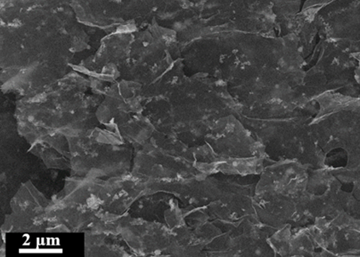
Influence of a binder on the electrochemical behaviour of Si/RGO composite as negative electrode material for Li-ion batteries
Abstract
Keywords
Full Text:
PDFReferences
Asenbauer J, Eisenmann T, Kuenzel M, Kazzazi A, Chen Z, Bresser D. The success story of graphite as a lithium-ion anode material – fundamentals, remaining challenges, and recent developments including silicon (oxide) composites. Sustain Energy Fuels. 2020;4(11):5387–416. doi:10.1039/D0SE00175A
Chae S, Choi S-H, Kim N, Sung J, Cho J. Integration of graphite and silicon anodes for the commercialization of high-energy lithium-ion batteries. Angew Chem Int Ed Engl. 2020;59(1):110–35. doi:10.1002/anie.201902085
Obrovac MN, Christensen L. Structural changes in silicon anodes during lithium insertion/extraction. Electrochem Solid State Letters. 2004;7(5):A93. doi:10.1149/1.1652421
Luo F, Liu B, Zheng J, Chu G, Zhong K, Li H, et al. Review – nano-silicon/carbon composite anode materials towards practical application for next generation Li-ion batteries. J Electrochem Soc. 2015;162(14):A2509–28. doi:10.1149/2.0131514jes
Wu H, Cui Y. Designing nanostructured Si anodes for high energy lithium ion batteries. Nano Today. 2012;7(5):414–29. doi:10.1038/35104644
Su X, Wu Q, Li J, Xiao X, Lott A, Lu W, et al. Silicon-based nanomaterials for lithium-ion batteries: A review. Adv Energy Mater. 2014;4(1):1300882. doi:10.1002/aenm.201300882
Shi Q, Zhou J, Ullah S, Yang X, Tokarska K, Trzebicka B, et al. A review of recent developments in Si/C composite materials for Li-ion batteries. Energy Storage Mater. 2021;34:735–54. doi:10.1016/j.ensm.2020.10.026
Wu J, Cao Y, Zhao H, Mao J, Guo Z. The critical role of carbon in marrying silicon and graphite anodes for high-energy lithium-ion batteries. Carbon Energy. 2019;1(1):57–76. doi:10.1002/cey2.2
Lestriez B, Bahri S, Sandu I, Roue L, Guyomard D. On the binding mechanism of CMC in Si negative electrodes for Li-ion batteries. Electrochem commun. 2007;9(12):2801–6. doi:10.1016/j.elecom.2007.10.001
Istomina AS, Bushkova OV. Polimernye svyazuyushchie dlya elektrodov litievykh akkumulyatorov chast’ 1. Polivinilidenftorid, ego proizvodnye i drugie kommertsializovannye materialy [Polymer binders for the electrodes of lithium batteries. Part 1. Polyvinylidene fluoride, its derivatives and other commercialized materials]. Elektrokhimicheskaya energetika [Electrochemical Energetics]. 2020;20(3):115-131. Russian. doi:10.18500/1608-4039-2020-20-3-115-131
Zhou X, Yin Y-X, Wan L-J, Guo Y-G. Self-assembled nanocomposite of silicon nanoparticles encapsulated in graphene through electrostatic attraction for lithium-ion batteries. Adv Energy Mater. 2012;2(9):1086–90. doi:10.1002/aenm.201200158
Ding N, Chen Y, Li R, Chen J, Wang C, Li Z, et al. Pomegranate structured C@pSi/rGO composite as high performance anode materials of lithium-ion batteries. Electrochim Acta. 2020;(137491):137491. doi:10.1016/j.electacta.2020.137491
Agyeman DA, Song K, Lee G-H, Park M, Kang Y-M. Carbon-coated Si nanoparticles anchored between reduced graphene oxides as an extremely reversible anode material for high energy-density Li-ion battery. Adv Energy Mater. 2016;6(20):1600904. doi:10.1002/aenm.201600904
Botas C, Carriazo D, Zhang W, Rojo T, Singh G. Silicon-reduced graphene oxide self-standing composites suitable as binder-free anodes for lithium-ion batteries. ACS Appl Mater Interfaces. 2016;8(42):28800–8. doi:10.1021/acsami.6b07910
Novikov D.V., Evschik E.Yu., Berestenko V.I., Yaroslavtseva T.V., Levchenko A.V., Kuznetsov M.V., Bukun N.G., Bushkova O.V., Dobrovolsky Yu. A. Electrochemical performance and surface chemistry of nanoparticle Si@SiO2 Li-ion battery anode in LiPF6-based electrolyte. Electrochimica Acta 2016;208:109–119. doi:10.1016/j.electacta.2016.04.179
Tokur M, Algul H, Ozcan S, Cetinkaya T, Uysal M, Akbulut H. Closing to scaling-up high reversible Si/rGO nanocomposite anodes for lithium ion batteries. Electrochim Acta. 2016;216:312–9. doi:10.1016/j.electacta.2016.09.048
Zhai W, Ai Q, Chen L, Wei S, Li D, Zhang L, et al. Walnut-inspired microsized porous silicon/graphene core–shell composites for high-performance lithium-ion battery anodes. Nano Res. 2017;10(12):4274–83. doi:10.1007/s12274-017-1584-5
Ogata K, Salager E, Kerr CJ, Fraser AE, Ducati C, Morris AJ, et al. Revealing lithium-silicide phase transformations in nano-structured silicon-based lithium ion batteries via in situ NMR spectroscopy. Nat Commun. 2014;5(1):3217. doi:10.1038/ncomms4217.
Feng J, Zhang Z, Ci L, Zhai W, Ai Q, Xiong S. Chemical dealloying synthesis of porous silicon anchored by in situ generated graphene sheets as anode material for lithium-ion batteries. J Power Sources. 2015;287:177–83. doi:10.1016/j.jpowsour.2015.04.051
Szczech JR, Jin S. Nanostructured silicon for high capacity lithium battery anodes. Energy Environ Sci. 2011;4(1):56–72. doi:10.1039/C0EE00281J
Kheirabadi N., Shafiekhani A. Graphene/Li-ion battery. J Appl Phys. 2012;112(12):124323. doi:10.1063/1.4771923
Xiao J, Xu W, Wang D, Choi D, Wang W, Li X, et al. Stabilization of silicon anode for Li-ion batteries. J Electrochem Soc. 2010;157(10):A1047. doi:10.1149/1.3464767
Casimir A, Zhang H, Ogoke O, Amine JC, Lu J, Wu G. Silicon-based anodes for lithium-ion batteries: Effectiveness of materials synthesis and electrode preparation. Nano Energy. 2016;27:359–76. doi:10.1016/j.nanoen.2016.07.023
DOI: https://doi.org/10.15826/chimtech.2020.7.4.21
Copyright (c) 2020 Korchun A.V., Evshchik E.Yu., Baskakov S.A., Bushkova O.V., Dobrovolsky Y.A.

This work is licensed under a Creative Commons Attribution 4.0 International License.
Chimica Techno Acta, 2014–2025
eISSN 2411-1414
Copyright Notice







